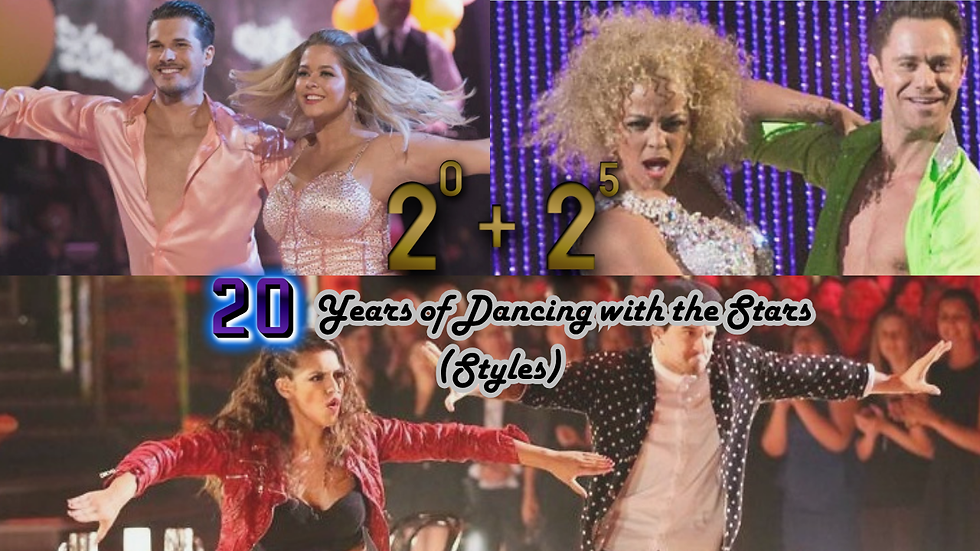2^0 + 2^5 (Origins)
- Jordan
- Jan 31
- 4 min read
Updated: Jun 15

Over 1 million rhinestones
14,548 spray tans
4,418 dances
394 celebrities
51 professional dancers
21 Emmy Awards
Those are just some of the stats given from an after-show celebration of Dancing with the Stars' 500th episode from season 33. Sprinkle in some more additions to close out the season, and you've got two decades worth of knowledge that's penetrated the stratosphere of the human race in its own glitzy way. How did we get here? Well, we have to take it back more than two decades ago to find out.
The British Are Back
Post-World War II, the British were worn out from constant battle, and a gloomy wherewithal had arose from the aftermath. An overall morale boost was evidently needed.
A turn to television could help increase that morale with its visual amenities, but the BBC had cut off their television broadcast during the war while leaving their radio broadcast on. With a dependence on the radio as the Brits form of media, it made it difficult for the BBC to garner interest for television once the war ended and television broadcast was brought back. An offer that was willing to submit itself to the ring, despite initial concern, was in the form of a program called Television Dancing Club.
Television Dancing Club showed a glimpse of the world of ballroom dance through dance lessons, competitions, and showdances. It debuted in 1948 and was joined two years later by another show that alternated airings with Television Dancing Club. That show was called Come Dancing and was similar in vein to Television Dancing Club with a higher emphasis on dancer regionality.
Television Dancing Club ended in 1964 while Come Dancing remained a mainstay (albeit a few years) until 1998. Either way, the longevity of both of these shows clearly showed how much the British community was mesmerized by the ballroom culture. Its elegance and charm evoked a glamorous essence that had been taken out for so long from World War II.
Between Television Dancing Club (left) and Come Dancing (right), British audiences became mesmerized with ballroom culture. The extravagant attire and vibrant movements brought sumptuous value for Great Britain during a time of economic difficulty. Additional welcomings toward up-and-coming dance styles like rock and roll (as seen with the Television Dancing Club image) helped vitalize that value for many years
The British Are Staying (Until They Suck)
At the turn of the new millennium, the idea of bringing back that magic that captivated the people of the UK was lurking. With reality TV starting to form itself into a static genre of television, Come Dancing was propositioned to be brought back in a re-imagined way as a reality TV show with the use of celebrities as dancers. Suggested at separate times by Richard Hopkins and Fernia Vardanis, the two would end up being brought together by the BBC to work on the installment. The end result was Strictly Come Dancing, and it debuted in 2004.
A portmanteau of Come Dancing and the 1992 ballroom film Strictly Ballroom, Strictly Come Dancing had celebrities learn ballroom dance styles from professional dancers (who they'd dance with on the show). A judging panel would score their efforts, and the public would vote on them afterward. Couples would get eliminated until one celebrity-pro pairing remained. From there, they'd be considered the winners.

There would be the fish-out-of-water drama, tension, self-discovery and perhaps even a twinkle of romance between the couples to keep viewers hooked. The series would also have a compelling narrative as viewers watched famous contestants struggling during rehearsals or finding delight in their ability to improve their skills. - Richard Hopkins on the potential for Strictly Come Dancing via an article from The Independent in 2012
The British Are Coming: Now With Sequins!
(I know that wasn't a World War II reference, but oh well)
After two successful seasons (or "series" as they called them), Richard took the show's concept overseas to America in hopes of it being a big success there. Attempts from the BBC to bring it over were deemed unsellable due to the heavy British tones associated with the program (though the concept did manage to get sold elsewhere).
Andrea Wong, the then executive vice-president of alternate programming for ABC, was the one who turned down the BBC offers, but when Richard tried to convince her, she eventually grew fond of its potential and got it running on a 2005 debut under the title Dancing with the Stars.

Alrighty! A great foundation of the show has been formed, but I'm just getting started. The next entry in this series will dive deeper into the American version of the show within the context of the first 20 years (hence why the American section was rather short here). Catch you then!











Comments